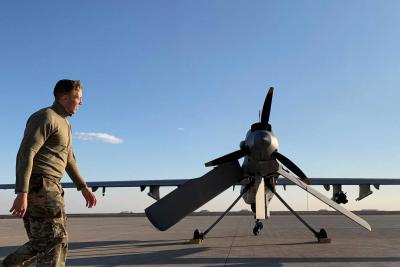Unmanned aerial vehicles (drones) have transformed the face of warfare over the past decade and have significantly altered the game. They have played a crucial role in numerous wars and battles, utilized by nations, organizations, and movements in their attacks and defenses.
Below is an overview of some ways in which drones have reshaped warfare, according to a report by the Wall Street Journal. Drones expand the fighters' line of sight and firing range, and they improve the accuracy of weapons launched from afar, such as artillery. They can also assist in identifying and targeting logistics networks, thereby increasing enemy supply lines and complicating operations.
Long-range drones can carry out operations in civilian areas far from the front lines without risking pilot safety. Moreover, drones make warfare relentless and pervasive; unlike soldiers, drones do not eat, sleep, or tire, and they are increasingly disposable. By connecting to a network, they can instantly share information with control units and among themselves. Their unblinking eyes eliminate safe havens on the battlefield, forcing forces to remain on constant alert, which is exhausting.
**Autonomy**
In parallel, these aircraft learn to recognize targets and operate independently. Delegating certain tasks to them, such as mapping terrain or identifying enemy positions, alleviates the workload on human operators, allowing them to focus on higher-order tasks. It remains uncertain whether this autonomy reduces or increases the risk of collateral damage.
**Low Cost**
Additionally, their low price and availability level the playing field between large and small armies. Battlefield drones have transitioned from advanced systems to consumer goods like missiles. Commercial drones are being adapted for combat use. Their proliferation forces larger armies to focus on advanced counter-drone technologies to maintain their superiority, pushing them towards mass production of drone armies.
**Powerful Impact**
Drones are replacing expensive missiles in some strikes, as the long-range varieties with large payloads require armies and governments to deploy stronger air defense systems in more locations. Rapid technological developments have led to an arms race to develop countermeasures and counter-countermeasures.
**Targeting Versatility**
Moreover, their versatility can help reduce collateral damage; smaller drones can enter buildings or other areas, which may minimize the destruction necessary to hit a target. This ability can assist armies in more effectively targeting enemy leadership.
**Artificial Intelligence**
In the near future, large numbers of drones will work in coordination with one another, guided by artificial intelligence, where remote operators will assign targets to the swarm, such as striking a specific target or preventing the enemy from achieving its objectives. AI will assign tasks to each drone, which will collaborate as a unified unit, much like fleets of combat aircraft do now.




